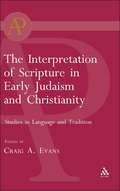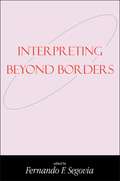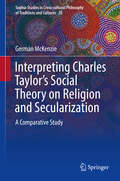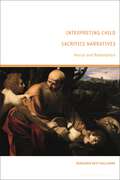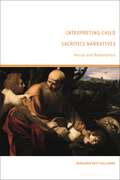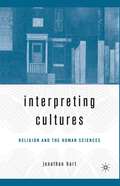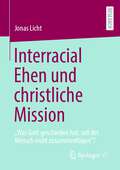- Table View
- List View
The Interpretation of Scripture in Early Judaism and Christianity: Studies in Language and Tradition (The Library of Second Temple Studies)
by Craig A. EvansThis volume assembles several important studies that examine the role of language in meaning and interpretation. The various contributions investigate interpretation in the versions, in intertestamental traditions, in the New Testament, and in the rabbis and the targumim. The authors, who include well-known veterans as well as younger scholars, explore the differing ways in which the language of Scripture stimulates the understanding of the sacred text in late antiquity and gives rise to important theological themes. This book is a significant resource for any scholar interested in the interpretation of Scripture in and just after the biblical period.
The Interpretation of the Bible: The International Symposium in Slovenia (The Library of Hebrew Bible/Old Testament Studies)
by Joze KrasovecThis unique volume, nearly 2000 pages in length and handsomely printed on Bible paper, is perhaps the most comprehensive scholarly work of our time on the translation and interpretation of the Bible. At its core are papers presented to an international symposium in Ljubljana in September 1996 to mark the publication of the new Slovenian version of the Bible, a landmark in Slovene identity and cultural life. In addition, its distinguished editor, Joze Krasovec, has commissioned a wide range of contributions devoted to translations of the Bible in many languages, including the Slavonic languages, Croatian, Czech, Hungarian, Polish and the Scandinavian languages. The 82 chapters in this work, mostly in English, are divided into three parts. Part I, on ancient translations and hermeneutics of the Bible, contains contributions by M.-E. Boismard, S.P. Brock, K.J. Cathcart, R.P. Gordon, L.J. Grech, M. Hengel, O. Keel, J. Lust, E. Tov and others, with a notable comprehensive bibliographic survey of oriental Bible translations from the first millennium by M. van Esbroeck. Part II, on Slavonic and other translations of the Bible, includes the first detailed study of the history of the Slavonic Bible, by Francis J. Thomson (over 300 pp.). Part III, with essays by such scholars as J.H. Charlesworth, D.J.A. Clines, J. Gnilka, M. G÷rg, N. Lohfink and A.C. Thiselton, concerns the interpretation of the Bible in translation, philosophy, theology, art and music. In an appendix, a complete list of printed Bibles in languages throughout the world is presented for the first time.
Interpreting 4 Ezra and 2 Baruch: International Studies (The Library of Second Temple Studies #87)
by Gabriele Boccaccini Jason M. ZurawskiIn this volume Gabriele Boccaccini and Jason M. Zurawski collect together essays from leading international scholars on the books of 4 Ezra and 2 Baruch. The literature of the Second Temple Period has become increasingly studied in recent years as scholars have begun to recognize the importance of these texts for a developed understanding of Rabbinic and Christian origins.Through close readings of the texts themselves, examining the books in comparison with other Jewish apocalyptic literature and early Christian materials, and reading the texts in light of their social and historical settings, the fifteen papers collected herein significantly advance the current scholarly conversation on these defining Jewish apocalypses written at the end of the first century CE, and they shed light on the everlasting legacy of apocalyptic ideas in both Christianity and Judaism.
Interpreting Beyond Borders (Bible and Postcolonialism)
by Fernando F. SegoviaThis book addresses a fundamental reality of our time: the great movement of people, for a variety of reasons, within and across countries and cultures. From this migration has emerged the 'diasporic intellectual': the state of dislocation and displacement has become a vantage point for reflection and interpretation. The same is true of theological studies in general and biblical criticism in particular. In this masterly treatment, Fernando Segovia focuses on the emerging transborder biblical interpreters from the Two-Thirds World now residing and working in the West, both in the United States and in Europe, and examines their multiple identities. He also explores how this state of 'in-betweenness' and homesickness affects, influences and informs biblical interpretation.
Interpreting Charles Taylor’s Social Theory on Religion and Secularization: A Comparative Study (Sophia Studies in Cross-cultural Philosophy of Traditions and Cultures #20)
by Germán McKenzieThis book examines “Taylorean social theory,” its sources, main characteristics and impact. Charles Taylor’s meta-narrative of secularization in the West, prominently contained in his major work A Secular Age (2007), has brought new insight on the social and cultural factors that intervened in such process, the role of human agency, and particularly on the contemporary conditions of belief in North America and Europe. This study discusses what Taylor’s approach has brought to the scholarly debate on Western secularization, which has been carried on mostly in sociological terms. McKenzie interprets Taylor’s views in a way that offers an original social theory. Such interpretation is possible with the help of sociologist Margaret Archer’s “morphogenetic theory” and by making the most of Taylor’s particular understanding of the method of the social sciences and of his philosophical views on human beings, knowledge and modernity. After exploring the philosophical and sociological sources informing Taylorean social theory and proposing its basic concepts and hermeneutic guidelines, the author compares it with two widespread theories of secularization: the now waning “orthodox” account and that proposed by Rational Choice Theory scholars, particularly prevalent in the United States. In doing so, the book shows in which ways Taylorean social theory supersedes them, what new issues it brings into the scholarly discussion, and what difficulties might limit its future development.
Interpreting Child Sacrifice Narratives: Horror and Redemption
by Benjamin Beit-HallahmiExamining the theme of child sacrifice as a psychological challenge, this book applies a unique approach to religious ideas by looking at beliefs and practices that are considered deviant, but also make up part of mainstream religious discourse in Judaism, Islam, and Christianity. Ancient religious mythology, which survives through living traditions and transmitted narratives, rituals, and writings, is filled with violent stories, often involving the targeting of children as ritual victims. Christianity offers Abraham's sacrifice and assures us that the “only begotten son” has died, and then been resurrected. This version of the sacrifice myth has dominated the West. It is celebrated in an act of fantasy cannibalism, in which the believers share the divine son's flesh and blood. This book makes the connection between Satanism stories in the 1980s, the Blood Libel in Europe, The Eucharist, and Eastern Mediterranean narratives of child sacrifice.
Interpreting Child Sacrifice Narratives: Horror and Redemption
by Benjamin Beit-HallahmiExamining the theme of child sacrifice as a psychological challenge, this book applies a unique approach to religious ideas by looking at beliefs and practices that are considered deviant, but also make up part of mainstream religious discourse in Judaism, Islam, and Christianity. Ancient religious mythology, which survives through living traditions and transmitted narratives, rituals, and writings, is filled with violent stories, often involving the targeting of children as ritual victims. Christianity offers Abraham's sacrifice and assures us that the “only begotten son” has died, and then been resurrected. This version of the sacrifice myth has dominated the West. It is celebrated in an act of fantasy cannibalism, in which the believers share the divine son's flesh and blood. This book makes the connection between Satanism stories in the 1980s, the Blood Libel in Europe, The Eucharist, and Eastern Mediterranean narratives of child sacrifice.
Interpreting Christian History: The Challenge of the Churches' Past
by Euan CameronThis book explores the theological lessons to be learnt from 2000 years of Christian Church history. An exploration of the theological lessons to be learnt from the difficult history of the Christian churches over the past 2,000 years Opens with an introductory essay on the whole of Church history, making the book suitable for lay readers as well as students Combines historical, historiographical and theological analysis Reunites the disciplines of theology and Church history Concludes that we can only ever perceive a facet of Christianity given our historical and cultural conditioning Written by a distinguished Church historian.
Interpreting Cultures: Literature, Religion, and the Human Sciences
by J. HartThis book focuses on how we perceive, know and interpret culture across disciplinary boundaries. The study combines theoretical and critical contexts for close readings in culture through discussions of literature, philosophy, history, psychology and visual arts by and about men and women in Europe, the Americas and beyond.
Interpreting Islam: Bandali Jawzi's Islamic Intellectual History
by Tamara SonnIn this book, Sonn provides the first English translation of The History of Intellectual Movements in Islam (1928), a seminal text of Arab modernism written by the Palestinian intellectual Bandali al-Jawzi (1871-1942). In that book, Jawzi offered the first Marxist interpretation of the history and development of Islamic thought. The continuing importance of his work lies in Jawzi's critical method of reevaluating both European "orientalist" and classical Muslim accounts of Islamic history. Fifty years before Edward Said's landmark Orientalism, Jawzi identified the vested imperial interests as the weakness in both methodologies. Sonn's translation brings to life this skillful and entertaining critique of Islamic history. Her introduction places Jawzi's thought in context with both postmodern intellectuals and Muslim reformers who continue the struggle to apply Islamic principles to contemporary life.
Interpreting Islam in China: Pilgrimage, Scripture, and Language in the Han Kitab (AAR Academy Series)
by Kristian PetersenDuring the early modern period, Muslims in China began to embrace the Chinese characteristics of their heritage. Several scholar-teachers incorporated tenets from traditional Chinese education into their promotion of Islamic knowledge. As a result, some Sino-Muslims established an educational network which utilized an Islamic curriculum made up of Arabic, Persian, and Chinese works. The corpus of Chinese Islamic texts written in this system is collectively labeled the Han Kitab. Interpreting Islam in China explores the Sino-Islamic intellectual tradition through the works of some its brightest luminaries. Three prominent Sino-Muslim authors are used to illustrate transformations within this tradition, Wang Daiyu, Liu Zhi, and Ma Dexin. Kristian Petersen puts these scholars in dialogue and demonstrates the continuities and departures within this tradition. Through an analysis of their writings, he considers several questions: How malleable are religious categories and why are they variously interpreted across time? How do changing historical circumstances affect the interpretation of religious beliefs and practices? How do individuals navigate multiple sources of authority? How do practices inform belief? Overall, he shows that these authors presented an increasingly universalistic portrait of Islam through which Sino-Muslims were encouraged to participate within the global community of Muslims. The growing emphasis on performing the pilgrimage to Mecca, comprehensive knowledge of the Qur'an, and personal knowledge of Arabic stimulated communal engagement. Petersen demonstrates that the integration of Sino-Muslims within a growing global environment, where international travel and communication was increasingly possible, was accompanied by the rising self-awareness of a universally engaged Muslim community.
INTERPRETING ISLAM IN CHINA AARA C: Pilgrimage, Scripture, and Language in the Han Kitab (AAR Academy Series)
by Kristian PetersenDuring the early modern period, Muslims in China began to embrace the Chinese characteristics of their heritage. Several scholar-teachers incorporated tenets from traditional Chinese education into their promotion of Islamic knowledge. As a result, some Sino-Muslims established an educational network which utilized an Islamic curriculum made up of Arabic, Persian, and Chinese works. The corpus of Chinese Islamic texts written in this system is collectively labeled the Han Kitab. Interpreting Islam in China explores the Sino-Islamic intellectual tradition through the works of some its brightest luminaries. Three prominent Sino-Muslim authors are used to illustrate transformations within this tradition, Wang Daiyu, Liu Zhi, and Ma Dexin. Kristian Petersen puts these scholars in dialogue and demonstrates the continuities and departures within this tradition. Through an analysis of their writings, he considers several questions: How malleable are religious categories and why are they variously interpreted across time? How do changing historical circumstances affect the interpretation of religious beliefs and practices? How do individuals navigate multiple sources of authority? How do practices inform belief? Overall, he shows that these authors presented an increasingly universalistic portrait of Islam through which Sino-Muslims were encouraged to participate within the global community of Muslims. The growing emphasis on performing the pilgrimage to Mecca, comprehensive knowledge of the Qur'an, and personal knowledge of Arabic stimulated communal engagement. Petersen demonstrates that the integration of Sino-Muslims within a growing global environment, where international travel and communication was increasingly possible, was accompanied by the rising self-awareness of a universally engaged Muslim community.
Interpreting the Qur'an: A Guide for the Uninitiated
by Clinton BennettPost 9/11, sales of translations of the Qur'an have greatly increased. Students and general readers alike are increasingly interested in the sacred writings of Islam. But the Qur'an can often make difficult reading. It lacks continuous narrative, and different types of material dealing with different topics are often found in the same chapter. Also, readers often attempt to read the book from start to finish and without any knowledge of the life and experiences of both Muhammad and the community of Islam. Introductions to the Qur'an attempt to make interpretation of these complex scriptures easier by discussing context, history and different interpretations, and presenting selective textual examples. Bennett's new introduction takes a fresh approach to studying the Qur'an. By reordering parts of the Qur'an, placing its chapters and verses into a continuous narrative, the author creates a framework that untangles and elucidates its seemingly unconnected content. Through this new approach the reader will come to understand various aspects of the Qur'an's interpretation, from Muhammad's life, to Muslim conduct and prayer, to legal considerations.
Interpreting the Qur'an: Towards a Contemporary Approach
by Abdullah SaeedHow is the Qur'an - central to all Muslim societies - to be understood today in order to meet the needs of these societies? Abdullah Saeed, a distinguished Muslim scholar, explores the interpretation of the ethico-legal content of the Qur'an, whilst taking into consideration the changing nature of the modern world. Saeed explores the current debates surrounding the interpretation of the Qur'an, and their impact on contemporary understanding of this sacred text. Discussing the text's relevance to modern issues without compromising the overall framework of the Qur'an and its core beliefs and practices, he proposes a fresh approach, which takes into account the historical and contemporary contexts of interpretation. Inspiring healthy debate, this book is essential reading for students and scholars seeking a contemporary approach to the interpretation of the Qur'anic text.
Interpreting the Qur'an: Towards a Contemporary Approach
by Abdullah SaeedHow is the Qur'an - central to all Muslim societies - to be understood today in order to meet the needs of these societies? Abdullah Saeed, a distinguished Muslim scholar, explores the interpretation of the ethico-legal content of the Qur'an, whilst taking into consideration the changing nature of the modern world. Saeed explores the current debates surrounding the interpretation of the Qur'an, and their impact on contemporary understanding of this sacred text. Discussing the text's relevance to modern issues without compromising the overall framework of the Qur'an and its core beliefs and practices, he proposes a fresh approach, which takes into account the historical and contemporary contexts of interpretation. Inspiring healthy debate, this book is essential reading for students and scholars seeking a contemporary approach to the interpretation of the Qur'anic text.
Interracial Ehen und christliche Mission: „Was Gott geschieden hat, soll der Mensch nicht zusammenfügen“?
by Jonas LichtReligion und Rassismus. Passt das zusammen? Jonas Licht weist in diesem Buch nach, dass die deutsche evangelische Missionsbewegung interracial Ehen zwischen 1850 und 1950 nicht gegen den sich rassifizierenden Zeitgeist verteidigte. Stattdessen eignete sie sich im Diskurs um interracial Ehen einen genuin „missionarischen Rassismus“ an.
Interrelatedness in Chinese Religious Traditions: An Intercultural Philosophy (Bloomsbury Studies in World Philosophies)
by Diana ArghirescuThe study of religions is essential for understanding other cultures, building a sense of belonging in a multicultural world and fostering a global intercultural dialogue. Exploring Chinese religions as one interlocutor in this dialogue, Diana Arghirescu engages with Song-dynasty Confucian and Buddhist theoretical developments through a detailed study of the original texts of the Chan scholar-monk Qisong (1007-1072) and the Neo-Confucian master Zhu Xi (1130-1200). Starting with these figures, she builds an interpretive theory focusing on “ethical interrelatedness” and proposes it as a theoretical tool for the study of the Chinese religious traditions. By actively engaging with other contemporary theories of religion and refusing to approach Chinese religions with Western frameworks, Arghirescu's comparative perspective makes it possible to uncover differences between the various Western and Chinese cultural presuppositions upon which these theories are built. As such, this book breaks new ground in the methodology of religious studies, comparative philosophy and furthers our understanding of the Confucian-Buddhist interaction.
Interrelatedness in Chinese Religious Traditions: An Intercultural Philosophy (Bloomsbury Studies in World Philosophies)
by Diana ArghirescuThe study of religions is essential for understanding other cultures, building a sense of belonging in a multicultural world and fostering a global intercultural dialogue. Exploring Chinese religions as one interlocutor in this dialogue, Diana Arghirescu engages with Song-dynasty Confucian and Buddhist theoretical developments through a detailed study of the original texts of the Chan scholar-monk Qisong (1007-1072) and the Neo-Confucian master Zhu Xi (1130-1200). Starting with these figures, she builds an interpretive theory focusing on “ethical interrelatedness” and proposes it as a theoretical tool for the study of the Chinese religious traditions. By actively engaging with other contemporary theories of religion and refusing to approach Chinese religions with Western frameworks, Arghirescu's comparative perspective makes it possible to uncover differences between the various Western and Chinese cultural presuppositions upon which these theories are built. As such, this book breaks new ground in the methodology of religious studies, comparative philosophy and furthers our understanding of the Confucian-Buddhist interaction.
Interreligiöse Hermeneutik in pluralen Gesellschaften: Begründungen, Herausforderungen, Chancen und Grenzen (Wiener Beiträge zur Islamforschung)
by Ibrahim Koçyiğit Şenol YağdıDie interreligiöse Hermeneutik erweist sich in einer von kultureller Vielfalt und religiöser Pluralität geprägten globalisierten Welt als unverzichtbar für den interreligiösen Diskurs. Sie bietet einen Rahmen für einen konstruktiven Dialog zwischen verschiedenen Glaubensrichtungen und ermöglicht den Brückenschlag zwischen unterschiedlichen religiösen Traditionen. Vor diesem Hintergrund leistet der vorliegende Sammelband zu theologischen und religionspädagogischen Begründungen einer interreligiösen Hermeneutik einen wichtigen Beitrag. Die Autor*innen reflektieren aus theologischer und philosophisch-hermeneutischer Perspektive und untersuchen verschiedene Aspekte, darunter interreligiöse Ansätze der Weltreligionen, theologische Grundlagen für den Dialog, die Ableitung einer interreligiösen Hermeneutik aus den heiligen Schriften und die Nutzung philosophisch-hermeneutischer Konzepte für die theologische Begründung des interreligiösen Dialogs. Diese kritische Reflexion und Weiterentwicklung einer pluralitätsfähigen Perspektive im interreligiösen Dialog trägt dazu bei, neue Wege für den theologischen Umgang mit religiöser Vielfalt zu eröffnen.
Interreligiöse Kompetenz: Theoretische Grundlagen - Konzeptualisierungen - Unterrichtsmethoden
by Joachim WillemsInterreligious Comparisons in Religious Studies and Theology: Comparison Revisited
by Perry Schmidt-Leukel Andreas NehringCan religions be compared? For decades the discipline of religious studies was based on the assumption that they can. Postmodern and postcolonial reflections, however, raised significant doubts. In social and cultural studies the investigation of the particular often took precedence over a comparative perspective. Interreligious Comparisons in Religious Studies and Theology questions whether religious studies can survive if it ceases to be comparative religion. Can it do justice to a globalized world if it is limited on the specific and turns a blind eye on the general? While comparative approaches have come under strong pressure in religious studies, they have started flourishing in Theology. Comparative theology practices interfaith dialogue by means of comparative research. This volume asks whether theology and religious studies are able to mutually benefit from their critical and constructive reflections. Can postcolonial criticism of neutrality and objectivity in religious studies create new links with the decidedly perspectival approach of comparative theology? In this collection scholars from theology and religious studies discuss the methodology of interreligious comparison in the light of recent doubts and current objections. Together with the contributors, Perry Schmidt-Leukel and Andreas Nehring argue that after decades of critique, interreligious comparison deserves to be reconsidered, reconstructed and reintroduced.
Interreligious Comparisons in Religious Studies and Theology: Comparison Revisited
by Perry Schmidt-Leukel Andreas NehringCan religions be compared? For decades the discipline of religious studies was based on the assumption that they can. Postmodern and postcolonial reflections, however, raised significant doubts. In social and cultural studies the investigation of the particular often took precedence over a comparative perspective. Interreligious Comparisons in Religious Studies and Theology questions whether religious studies can survive if it ceases to be comparative religion. Can it do justice to a globalized world if it is limited on the specific and turns a blind eye on the general? While comparative approaches have come under strong pressure in religious studies, they have started flourishing in Theology. Comparative theology practices interfaith dialogue by means of comparative research. This volume asks whether theology and religious studies are able to mutually benefit from their critical and constructive reflections. Can postcolonial criticism of neutrality and objectivity in religious studies create new links with the decidedly perspectival approach of comparative theology? In this collection scholars from theology and religious studies discuss the methodology of interreligious comparison in the light of recent doubts and current objections. Together with the contributors, Perry Schmidt-Leukel and Andreas Nehring argue that after decades of critique, interreligious comparison deserves to be reconsidered, reconstructed and reintroduced.
Interreligious Dialogue and the Partition of India: Hindus and Muslims in Dialogue about Violence and Forced Migration (Studies In Religion And Theology Ser.)
by Mario I. AguilarIn a time of schism, violence and forced migration, how can God be understood? With his latest book, Catholic Benedictine hermit Mario Aguilar explores the religious identities of Hindus and Muslims in the aftermath of the 1947 partition of India. Looking at the experiences of the victims who were silenced, he reveals how out of this traumatic period has emerged a peaceful dialogue between faiths, held together by shared humanity and prayerfulness. Founded on a fascination with what unites rather than divides religions, Aguilar offers a theological reading of a major event in twentieth century history that is both creative and constructive.
Interreligious Dialogue and the Partition of India: Hindus and Muslims in Dialogue about Violence and Forced Migration (PDF)
by Mario I. AguilarIn a time of schism, violence and forced migration, how can God be understood? With his latest book, Catholic Benedictine hermit Mario Aguilar explores the religious identities of Hindus and Muslims in the aftermath of the 1947 partition of India. Looking at the experiences of the victims who were silenced, he reveals how out of this traumatic period has emerged a peaceful dialogue between faiths, held together by shared humanity and prayerfulness. Founded on a fascination with what unites rather than divides religions, Aguilar offers a theological reading of a major event in twentieth century history that is both creative and constructive.
Interreligious Dialogue Models: From the Life of the Prophet Muhammad (Routledge Studies in Religion)
by Alwani Ghazali Muhammad KamalHow did the Prophet Muhammad (pbuh) converse and engage with other religious believers? Did he start off with prejudice and mistrust? Or was he convivial and open-minded? This book analyses six models of the dealings in the lifetime of the Prophet Muhammad (pbuh), specifically, but not restricted, to the siblings of Abrahamic religious believers. The six models of dialogue analysed in the book are dialogue with Ashamah, Najashi of Abyssinia, delegation of Najran Christians, different Jews of Yathrib, and emperors of Byzantine and Sassanid. The analysis applies Ibn Khaldun’s (d.1406) historical approach which the author termed as Khaldunian Hermeneutics due to the similarity between his ideas to that of Johann Gustav Droysen (d. 1884), a German philosopher, in historical hermeneutics. As such, the analysis goes beyond the dialogue content, taking into consideration the immediate and larger contextual settings, and changes of the contexts due to the passage of time. It critically considers the suitability of each model due to the difference in times and contexts. The book serves as a reference for Muslim dialogue advocates and practitioners, to provide substantial evidence of the dialogue application by the role model of Muslims – the Prophet Muhammad (pbuh) whom they hold very dear to their hearts.
